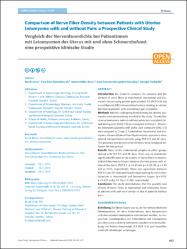Comparison of Nerve Fiber Density between Patients with Uterine Leiomyoma with and without Pain: a Prospective Clinical Study

Göster/
Erişim
info:eu-repo/semantics/openAccessTarih
2018Yazar
Giray, BurakEsim-Büyükbayrak, Esra
Hallac-Keser, Sevinç
Karşıdağ, Ayşe Yasemin Karageyim
Türkgeldi, Ayşegül
Üst veri
Tüm öğe kaydını gösterÖzet
Introduction We aimed to compare the presence and the amount of nerve fibers in endometrial, myometrial and leiomyoma tissues using protein gene product 9.5 (PGP 9.5) and neurofilament (NF) immunohistochemical staining in uterine leiomyoma patients with and without pain complaint. Methods Patients undergoing hysterectomy for uterine leiomyoma were prospectively enrolled in the study. Twenty-five uterine leiomyoma patients without pelvic pain complaint (visual analog scale (VAS) < 5) were assigned to Group 1; 23 uterine leiomyoma patients with pelvic pain complaint (VAS >= 5) were assigned to Group 2. Endometrial, myometrial and leiomyoma tissues obtained from hysterectomy specimens were stained immunohistochemically using PGP 9.5 and NF dyes. The presence and density of nerve fibers were compared between the two groups. Results None of the endometrial samples in either groups stained with PGP 9.5 and NF dyes. There was no statistically significant difference in the number of nerve fibers in myometrial and leiomyoma tissues between the two groups with either of the stains (PGP 9.5: p = 0.39 and p = 0.29; NF: p = 0.83 and p = 0.65, respectively). There was agreement between PGP 9.5 and NF immunohistochemical staining for nerve fiber detection in myometrial and leiomyoma tissues (p < 0.05/kappa = 0.622 and p < 0.05/kappa = 0.388, respectively). Conclusion This study demonstrates that the quantity and density of nerve fibers in myometrial and leiomyoma tissue in patients with pain were similar to that in patients without pain.


















